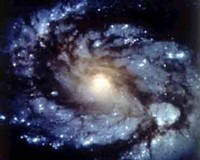|
     
>
History
>
Life Cycle of Galaxy
> Types of Galaxies
> Distribution of
Galaxies
> Milky Way Galaxy
> Andromeda
Galaxy
      
|
A galaxy is a
large gravitationally bound system of stars, interstellar gas and dust,
unseen dark matter, and possibly dark energy. Typical galaxies contain 10
million to one trillion (107 to 1012) or more stars, all orbiting a common
center of gravity. In addition to single stars and a tenuous interstellar
medium, most galaxies contain a large number of multiple star systems and
star clusters as well as various types of nebulae. Most galaxies are
several thousand to several hundred thousand light years in diameter and
are usually separated from one another by distances on the order of
millions of light years.
Although so called dark matter and dark energy appear to account for well
over 90% of the mass of most galaxies, the nature of these unseen
components is not well understood. There is some evidence that super
massive black holes may exist at the center of many, if not all, galaxies.
Intergalactic space, the space between galaxies, is a near vacuum with an
average density of less than one atom per cubic meter of gas or dust.
There are probably more than 1011 galaxies in the visible universe.
 |
Galaxy M100
The spiral galaxy M100 is between 35
million and 80 million light-years from the earth. The Hubble Space
Telescope captured this image of the core and spiral arms of M100
after repairs had been made to the telescope in December 1993. |
[Back] [Top] [Next]
|
